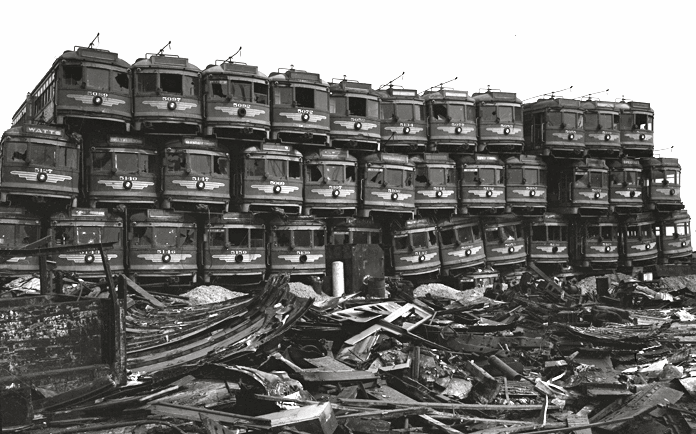Once upon a Time, America had electric street cars. Then, in a grand swindle known as the Great American Streetcar Conspiracy, General Motors, Firestone Tire, Standard Oil of California, Phillips Petroleum, and Mack Trucks formed a shell company that bought out urban streetcar companies and replaced them with companies that would only use buses - and who would only buy buses, trucks, tires, gas and oil from consortium members.
San Francisco mayor and antitrust attorney Joseph Alioto testified that "General Motors and the automobile industry generally exhibit a kind of monopoly evil", adding that GM "has carried on a deliberate concerted action with the oil companies and tire companies...for the purpose of destroying a vital form of competition; namely, electric rapid transit." Los Angeles mayor Tom Bradley also testified, saying that GM—through its subsidiaries (namely PCL) "scrapped the Pacific Electric and Los Angeles streetcar systems leaving the electric train system totally destroyed"

In the end, in cities all across America existing electric streetcar lines were torn up and scrapped, replaced by gasoline powered transport and the industry's campaign to establish gas-powered hegemony and dependence was completely successful. To belabor the point: people do plan and dream to replace public transit systems with their own designs; it's happened not too long ago.
Brilliant people at Google are producing a no-driver car. It will not have a place for a driver, because the affordances given to a driver - a steering wheel, brakes, an accelerator - would only interfere. At one time it was said, The factory of the future will have machinery, a dog, and a man. The man's function is to feed the dog. The dog's function is to keep the man away from the machinery. With this new vehicle, Google has done away with the need for both the dog and the man, which represents a significant cost savings.
Lyft and Uber are spending millions if not billions of venture capitalist money establishing urban on-demand taxi services, mediated by apps rather than dispatchers, driven by independent sub-contractors. In general, these new entrants into the marketplace have been seen as competitors to legacy cab companies and limo services, sort of an upscale jitney cabs outfit that goes into the finest neighborhoods.
Suppose that these aren't disparate stories but are instead threads of convergence - suppose an integrated self-serve, web-intermediated driverless car service isn't intended to cherry pick the most profitable customers away from a transit system, but instead it's designed to replace most of the transit system?

What's the most expensive aspects of a transit system? Two things: (1) universal frequent coverage and (2) employees. A truly effective transit system has to be able to get a person wherever they want to go in the city, whenever they want to get there or else people will invest in workarounds (like cars); it takes a lot of employees to staff a comprehensive hi-frequency transit system, and public transit employees often have good benefit packages. Mature transit systems are challenged by retirement expenses and budget constraints.

Uber CEO Travis Kalanick talked about driverless Uber-cars last week, “The reason Uber could be expensive is because you’re not just paying for the car — you’re paying for the other dude in the car”.
So now, let's imagine a proposal where the transit system of 2020 consists of large vehicles (buses, maybe) along major thoroughfares from 0600 through the end of evening rush hour, and Google-Lyft-Web cars on a point-to-point system for non-artery, off-peak travel.
Is it expensive? Sure, but you're replacing people with machines - no benefits, no retirements, no worker's comp, no unions. And you're increasing after-hours service coverage.

SO if you're brilliant, you're not building no-driver cars just so you can compete with Chevy; you want to sell fleets of them, wholesale not retail. You want to sell them in a game-changing, disruptive way. You want to have the ground prepared, with a twist.
That's why Lyft and Uber don't have their knickers in knots about drivers and insurance; those Millenials are just transitional problems. The drivers are a temporary issue, a meatspace kludge until the fun stuff starts to happen. In the meantime they're figuring out exactly how to run a self-serve, web-dispatched point-to-point transportation system, and other people are paying for it. Sweet!
So cities will still have Bus Rapid Transit, and bus lines along main thoroughfares during rush hours (for a while, at least). But it's probably a bad time to be starting a career as a bus driver.



0 comments:
Post a Comment
Comments and Feedback? Love that stuff. Please leave your thoughts in the box below--